If a person notices that the skin on the lower extremities has begun to peel and look dry and unhealthy, then they definitely need proper care. However, before starting any action, it is recommended to go for a consultation with a doctor, who will make a preliminary diagnosis and, if necessary, prescribe additional examination.
After all, it also happens that such symptoms are not only cosmetic in nature, but also signal serious disorders in the body. Human skin is a kind of protective barrier, thanks to which the body remains healthy. This becomes possible due to the fact that the skin does not allow many unfavorable factors to enter: toxins, bacteria, etc.
Initially, you need to figure out why the skin on your legs below the knees is peeling, and only then begin therapeutic or cosmetic measures to restore its normal appearance. Of course, first of all, dry skin of the lower extremities is unsightly, but this condition is often accompanied by unpleasant sensations: itching, pain, peeling, redness, burning, etc.
Causes
In total, doctors identify 5 groups of reasons why such changes occur:
- influence of external factors;
- age-related changes in the body;
- progression of chronic diseases;
- infectious lesion;
- poor nutrition.
Let's look at each point in more detail.
It’s worth saying right away that most of the factors that lead to peeling of the skin on the legs below the knees can be eliminated without much effort and specific treatment. Many people who have a fairly sensitive epidermis have peeling feet when exposed to aggressive wind, sun, cold, water and air. People with dry skin type suffer the most under such conditions.
The solution to the problem may be to use a rich cream when you go outside in frosty weather, but if it’s summer outside, then cosmetics with increased ultraviolet protection will come in handy (men should also not neglect these recommendations). If the air in the room is dry, then you need to install a humidifier or several containers of water. To humidify the air, you can wash the floors more often without wiping them dry.
If a person uses a foot cream that is not suitable for their skin type, peeling may also occur. Therefore, before buying any cosmetics, it is better to carefully read the recommendations and instructions of the manufacturer. When girls often exfoliate their legs, the function of their sebaceous glands is inhibited, so such products should be used only when absolutely necessary.
Peeling of the legs below the knees can be a symptom of the body's reaction to a food irritant. Simply put, a person has an allergy. In this case, peeling is accompanied by itching. Provocateurs can be artificial and natural materials from which clothes and shoes are made, as well as dust, animal hair, household chemicals and much more. To solve the problem, you need to limit contact with the irritant, or completely eliminate it, and also consult with your doctor about which antihistamines are best to take.
The cause of peeling legs may be insufficient fluid intake, that is, dehydration. To prevent this, you need to drink at least one and a half liters of clean water per day. If you do not heed this recommendation, gradually, starting from the shin area, the peeling will reach the thigh, and even then the process will become irreversible, and it will be impossible to cope with it.
In addition to a small amount of fluid, legs in this condition can be due to the abuse of anti-cellulite products, violation of the rules of visiting the sauna, etc.
External reasons
Your feet, or rather the skin, will not start to become dry and flaky just like that. There are many external factors that provoke the development of this condition, but their complex impact is considered the most dangerous.
Reasons of this type include:
- Excessively dry air in the living room during the heating season.
- Incorrect wearing of underwear for weight loss, stockings and socks made of synthetic materials, and especially if they still have a tightening effect, which contributes to squeezing blood vessels, poor circulation and improper nutrition of cells.
- Aggressive exposure to ultraviolet radiation, including regular visits to the solarium.
- Swimming in water with a high chlorine content (swimming pools).
- Lack of water purification filters at home.
In most cases, eliminating external negative factors is not difficult.
Age
Unfortunately, no person can influence the natural processes of the body and stop aging. After 50 years, and for some people even earlier, changes in the structure of the skin begin to occur: they become thinner, lose moisture, which leads to peeling of the legs and other areas. This condition is caused by changes in collagen fibers, which are the main building element of the epidermis.
To solve the problem, it is recommended to eat more foods that contain collagen, and also not to neglect drinking clean water, which will help normalize lipid and fat metabolism in tissues.
Infections
Peeling of the skin of the legs can occur due to the penetration of pathogenic infections and microorganisms into the epidermis. One of the most common causes is a fungal infection, which can be “caught” in any public place through contact with a carrier of the infection. In addition to dryness and flaking, the feet are very itchy, especially between the toes, involving the foot and lower leg.
For such a disease, therapy is prescribed only by a doctor, but the patient is first advised to undergo an examination with tests that will help determine the type of fungal infection.
In addition to fungus, dryness and flaking of the lower extremities can be a symptom of eczema, dermatitis, psoriasis or Kawasaki disease. Therapy should also be prescribed by a qualified dermatologist and after laboratory diagnosis.
In addition to skin diseases, itching, dryness, redness and peeling of the legs occur in the presence of concomitant pathologies, including:
Speaking about medications, it is worth noting that if a person takes a lot of hormonal drugs, then the legs can also peel very much below the knees. Similar conditions are observed with short-term or long-term use of ointments with hormones, which lead to dysfunction of the stratum corneum of the epidermis.
Nutrition
Feet can become cracked in people who neglect a balanced diet. The diet of a healthy person should always contain large quantities of fresh vegetables and fruits, vegetable oils, fish and seafood.
But if vitamin deficiency is observed in the body, then peeling of the skin below the knees cannot be avoided. Excessive consumption of drinks containing caffeine (black tea and coffee) and alcohol can also lead to a similar change in the epidermis of the leg.
Prevention
If you don’t want your feet to start cracking, peeling, or itching, then it is recommended to follow standard prevention rules. If a person visits a swimming pool, sauna, wears someone else’s slippers, or buys shoes to try on in a store, then it is recommended that he always put on disposable socks first. This way you can avoid direct contact with pathogenic bacteria, because your foot will be protected. You still can’t use the same personal hygiene items, as the fungus is transmitted very quickly.
As for the condition of the body, first of all it is necessary to promptly treat all skin diseases. You definitely need to fill your diet with healthy foods and give up fast food.
If a person is allergic, then he should take care to reduce contact with the irritant. During autumn, winter and spring, when there is a serious lack of nutrients, you need to take vitamin complexes. And always remember that low fluid intake will lead to dehydration, which in turn causes dry and flaky skin on your feet.
Girls should carefully approach the choice of cosmetics; do not neglect the suitability of skin type and recommendations for creams. If possible, it is necessary to find a replacement for peeling if peeling of the skin of the legs below the knees is observed after it.
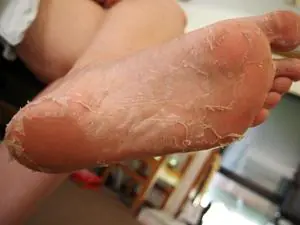
It's no secret that every girl wants to be the most charming and attractive. To achieve perfection, girls spend a lot of time on caring for the skin of their face, body and hair, and also spare no expense on playing sports and trying to lead a healthy lifestyle. But sometimes, at the most unexpected moment, some unpleasant omission can ruin your mood. This includes severe peeling of the skin on the legs, which is much more difficult to deal with than problems, for example, on the hands. As a result, you have to give up short skirts. Let's figure out why the skin on your feet dries and peels, and how to stop this process.
Main reasons
There are many different factors, contributing to the appearance of scales on the skin.
To the most common reasons peeling and cracking on the legs include:
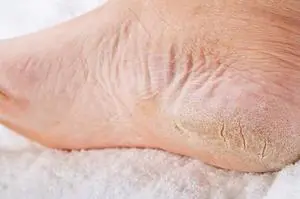
Moisture deficiency. When the skin of the legs is very dry and dehydrated, the peeling process begins, and the calves and feet are especially affected. In summer, the cause of this problem is high air temperature, in winter it is a long stay in a heated room.- Poor quality clothing - uncomfortable or rubber shoes, stockings or synthetic tights - leads to skin irritation, and a violation of the water-lipid balance - to the appearance of cracks in the legs and heels.
- Improper drinking regime. You need to drink at least a liter of water every day.
- Cosmetical tools. Regular use of deodorants or other alcohol-containing preparations for sweaty feet can dry out the skin of your feet. To get rid of unwanted problems, you should stop using them, and also not use hard washcloths and use less aggressive means.
- Natural influence. Sometimes itching and dryness on the feet can be due to climate change or due to prolonged exposure to the sun or frost.
- Psycho-emotional state. Due to frequent stress, fatigue and negative emotions, the structure of the skin may change. In this case, you should relax and switch to positive emotions.

Changes in hormonal levels. With age-related changes and menopause, the skin can become very dry and cracked.- Increased sweating. Wet skin becomes overcooled and begins to dry out. As a result, cracks form between the fingers.
- Poor nutrition and vitamin deficiency. It is imperative to eat foods that contain vitamins A, B, D, E, zinc and omega acids.
- Fungal infection. If the skin between your toes peels off and itches, this indicates foot fungus. In this case, you need to consult a dermatologist and undergo treatment with medications, otherwise the fungus may spread to other parts of the body.
- Allergy. Itching, rashes and peeling can be caused by eating sweets and citrus fruits.

And also the reasons why the skin on the feet peels may be a violation of the regenerative abilities of cells; they manifest themselves as a result of diseases such as eczema, psoriasis, diabetes, dermatitis, etc.
Due to sedentary lifestyle many physiological processes are disrupted that affect the condition of the skin on the legs in the area below the knees. Therefore, to avoid these defects you need to move more and play sports.
Itching and dryness of the lower legs can occur with diseases such as dermatitis, mycosis, herpes and eczema, which manifest themselves in the form of a rash, and later merge into a spot. As a rule, with such lesions, rashes appear on the skin, which subsequently merge into a single spot.
How to deal with dryness and flaking
There are many ways to cope with dryness and flaking:
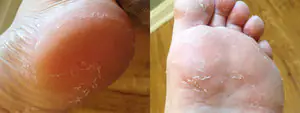
Folk remedies. Apply any oil to your feet, for example: vegetable, butter, essential or any fatty cream.- Medicines that can be bought at a pharmacy. In winter, take vitamin complexes.
- Baths. During an exacerbation, it is better to avoid baths with hot water, and choose warm baths with ethers. But before taking them, you need to test for an allergic reaction, especially if you use cinnamon or orange oil.
- Wrapping, for example, with seaweed or honey.
- Change your depilation method. Often, after an electric depilator, the skin becomes dry and irritated, so it is better to give preference to depilation using wax or powdered sugar.
It is very important not to self-medicate for serious skin diseases, as this can infect others, but seek treatment to an experienced specialist for help to prevent serious consequences.
Prevention of the problem
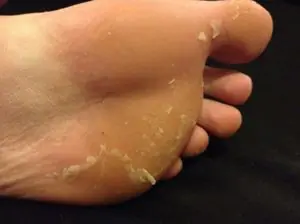
To prevent dryness and flaking, you need to drink at least two liters of water, eat fish, which contains a lot of amino acids, and do not wear nylon tights in cold weather. When indoor air is dry, moisturize it further, filling the container with water and placing it on the battery.
Often, women and men do not take the time to care for their feet, which results in many unpleasant surprises. After all, in order for your feet to withstand the dynamics of life and function properly, you need to take good and proper care of them.
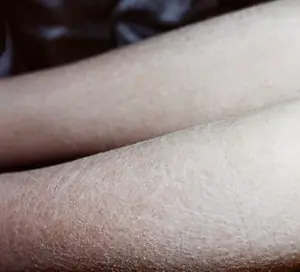
Cleanse: steam your feet and use a special machine or stone to remove dead skin particles, and also massage this area. As a result, blood flow will be restored.- Use rich creams and wear cotton socks after application. Do this procedure four times a month. This will make your skin smooth.
- Try to regularly use sea salt baths. They will help prevent many vascular diseases and relieve fatigue.
Dry mint and St. John's wort will refresh your feet. The conifer family, thyme and oak will prevent sweating. Calendula and chamomile leaves are antiseptics and promote the healing of microdamages. Potato decoction will quickly soften your feet. Dry mustard powder will restore the body's protective functions.
Recommendations from dermatologists
A contrast shower for five minutes has a beneficial effect on the skin of the feet, and if there is excessive sweating, reduce the time by half. The water should be at a comfortable temperature. If you have venous diseases accompanied by inflammatory processes, it is necessary to use a cooling bath. The temperature should be slightly lower than the room temperature. These procedures will normalize the balance of the skin and the production of its secretion. As a result of such foot care, the skin will become healthier, and foot diseases will not bother you.
Thus, by taking proper care of the skin of your feet, you can not only get rid of dryness and flaking, but also prevent many diseases. So don't neglect it, because beautiful well-groomed legs always attract male attention.
When dry skin appears below the knees, it causes significant discomfort to a person. Of course, you can lubricate it with moisturizer and wait until the dryness goes away. But this can last for years, which is quite uncomfortable.
To finally get rid of the problem, you need to find out what causes peeling of the legs below the knee and eliminate them. If this is not done, the affected area may spread to other areas of the skin.
Causes of peeling
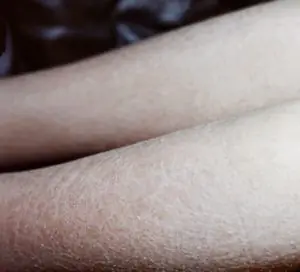
All the reasons that can cause dry skin on the legs are divided depending on the cause. Most of the factors are external influences that can be easily eliminated and then the skin of the legs will return to its normal state. But there is a small chance that the peeling is a sign of a serious internal disease that requires medical attention.
External factors
Peeling skin may be the first warning sign of serious internal diseases. But if it is localized in one area and itches, then most often it is the result of external influences. There are a large number of reasons that can affect the skin of the feet, and it is impossible to take them all into account. Therefore, it is necessary to know the main factors that affect the legs.
- Dry air due to heating or constant use of air conditioning.
- Allergic reaction to household chemicals.
- Allergy to cosmetics.
- Wearing clothes (underwear, pants, socks) that are small, which causes pressure on the blood vessels in the legs and uneven distribution of nutrients. This effect can also be caused by shapewear of the wrong size, or worn on the body for more than 5 hours.
- Dry skin due to excessive exposure to ultraviolet rays.
- Contact with skin of liquids with a high content of chlorine or other impurities that are used in tap water. This effect can be achieved both by home water treatments and by going to the pool.
- Infectious diseases affecting the skin.
- Wearing winter boots in a well-heated room.
Most of the external factors are easily removable, but if remission does not occur after taking preventive measures, you should consult a doctor. After all, this may be the first sign of the development of a serious disease. You should also do this if redness appears at the site of peeling, because this is most likely an infection.
Internal diseases
The causes of peeling legs below the knees may be a violation of the health of the body. Dry skin can occur either from local damage or from a general disease.
Common causes of dry skin:
- diabetes;
- disturbances in liver function;
- kidney dysfunction;
- erythroderma;
- psoriasis;
- eczema.
Internal causes also include a sedentary lifestyle. Because of this, veins and blood vessels are compressed, which leads to the supply of fewer nutrients necessary for the skin. This makes itself felt even if a person plays sports after a long day of work at the computer.
If the skin of the legs below the knees dries out due to an internal disease, then it is impossible to cure it on your own. Only a qualified doctor can accurately determine the cause and create the most appropriate course of treatment.
Therefore, before trying home methods, you should undergo a medical examination that will identify the source. And after treatment, you can use preventive measures and home methods for healing your skin.
Preventive measures
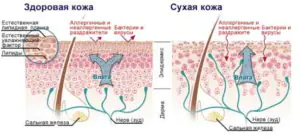
When the skin on a woman's legs peels below the knees, it is easier to cure the disease once, and then constantly maintain the condition of the skin. This is much easier to do than having medical procedures done every six months.
- It is very important to humidify the air in the apartment, especially during the heating season.
- You should avoid antibacterial soaps or those that contain many additional substances (dyes, fragrances).
- Use only proven high-quality cosmetics that do not contain toxic additives.
- Exfoliate the skin every week to get rid of dead particles from the feet.
- Moisturize your legs and feet with coconut oil or body milk.
- Reduce the amount of synthetic clothing adjacent to the affected area.
- Remove boots or other warm footwear indoors.
- When working sedentarily, alternate periods of immobility with walking. The most useful thing is to get up and walk every 20 minutes. This will have a beneficial effect not only on the skin, but also on work productivity.
Home care methods

External effects will be ineffective if the lack of nutrients that are necessary for the skin is not eliminated. Therefore, you should reconsider your diet. It is advisable to increase the amount of stewed fish and fresh salads seasoned with vegetable oil.
It is also important to eat grains rich in fiber. Doctors recommend starting courses of vitamin supplements in late autumn and early winter. This is necessary in order to support the body, which suffers from a lack of fresh greens, fruits or vegetables.
If the reason is insufficient subcutaneous blood circulation, then you can strengthen it with the help of foot baths. For this, procedures not only with warm water are suitable, but also quick dipping into containers of different temperatures.
If the skin of your feet is steamed, you can add a decoction of herbs that will help reduce peeling. Oak bark, chamomile, sage or St. John's wort are good options. It is advisable to alternate them throughout the course.
If the skin is insufficiently nourished, you can deliver beneficial substances using a foot mask. To do this, you need to purchase vitamins A and E at the pharmacy, which are sold in ampoules. You will also need 100 g of thick sour cream and 40-50 g of coconut oil.
Sour cream and butter are thoroughly mixed, then 1 bottle of medicine is added and the mixture is applied to the feet. The entire smeared surface is wrapped in cling film for 20 minutes so that the vitamins do not oxidize in the air. After completion, simply rinse off the substance with warm water.
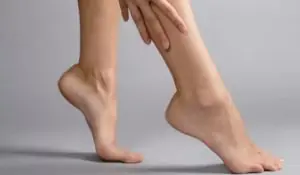
Cleansing with paraffin. Depending on the affected area, you will need 2-3 thick suppositories. They are lit and gently dripped onto flaky skin so that the drop does not burn. When the piece hardens, cover the area nearby. Do not bring the candle very close to the skin, otherwise you may get burned. And after the entire affected area has disappeared, the procedure is repeated 1-2 more times. After this, the leg is wrapped in cling film, and after 1 hour it is thoroughly cleaned with fine pumice. The course consists of 5-10 procedures. When carrying out the last 4-5 wrapping procedures, it is advisable to use beeswax candles.
It is important to remember that this procedure can only be carried out if there are no scratches, otherwise the hot mass will corrode the wound.
Finding the cause of dryness and eliminating it is the best way to cure peeling feet. If you react early, you can avoid the cost of restoring the affected area. It is best to immediately consult a doctor who will help exclude serious diseases and skin infections from the group of causes.



